Ryan Hall's Blog, page 181
March 16, 2017
Galen Rupp Makes His Boston Marathon Debut Amid A Storm
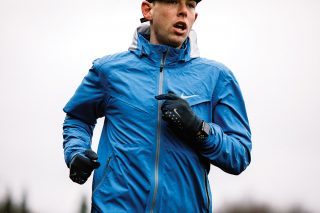
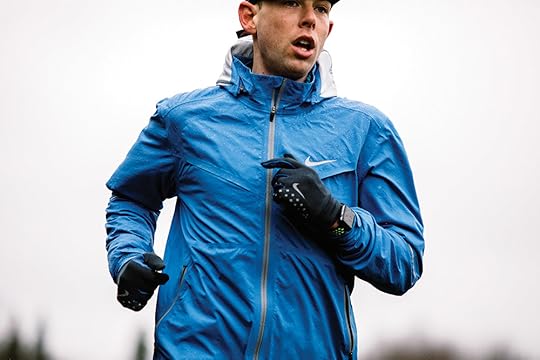
Galen Rupp is America’s greatest distance runner. His sole focus on the marathon now would be—should be—widely celebrated. But even with his seemingly unlimited potential, old story lines continue to steal the spotlight.
All his life, Galen Rupp has been weathering various storms. After all, he’s a native Oregonian. Doesn’t matter that the air is damp and cold, as it often is, or rain is dumping from the sky, as it often does. Here, workouts don’t get called off, and soccer games and track meets don’t get postponed. Because Oregonians don’t get forced indoors like those in the Midwest or Northeast. They plug ahead in wretched conditions, letting nothing stop them—no matter how gray the outlook, no matter how miserable they feel inside.
This environment helped forge Rupp into who he is. And the 30-year-old is, by nearly any measure, America’s greatest distance runner right now. He’s been to three Olympics, taking home a silver medal in the 10,000 meters in 2012 and bronze in the marathon in 2016, each a monumental accomplishment for an American in events where east Africans tend to sweep the podium spots.
And if it were possible to add a footnote to a medal, that bronze would deserve it, for it was only Rupp’s second ever attempt at a marathon. (He won his very first attempt, the Olympic Trials marathon earlier in 2016). He is also the toast of the Nike Oregon Project, the most exclusive and resourced running team in the world—and, by extension, Nike itself, which takes great pride in its origins as a running company.
Now, Rupp is ready to start a new chapter, focusing his attention solely on the marathon. His ultimate goal, he says, is gold in the 2020 Olympic Marathon. Rupp trading track for asphalt should be a huge deal. He’s a once-in-a-generation athlete—one of the only Americans to beat many of Kenya’s and Ethiopia’s finest runners. Nobody knows his ceiling in the marathon—and that tantalizing notion is an exciting prospect in American distance running, which has been waiting for the next native-born world-beater for decades.
Or at least it should be. But something keeps getting in the way—something he can’t outrun, or, as yet, outlast. A leitmotif that returns in his new chapter: It’s a lingering suspicion in the running world and in the media that the Nike Oregon Project operates in a gray area of performance enhancement. In a nutshell, the program is accused not of using illegal substances, necessarily, but rather using legal substances in what may be illegal—or, some think, unethical—ways.
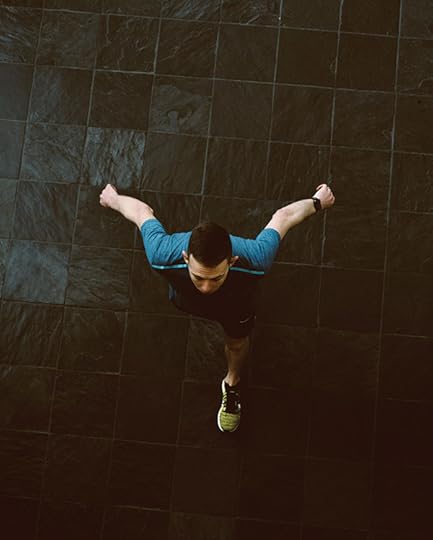
The Nike Oregon Project’s coaches and its athletes have not been charged with anything to date after four years of investigation by the U.S. Anti-Doping Agency. But media reports keep returning—the latest in late February, concerning an unpublished USADA report that was found by Russian hackers and contained few new nuggets of allegations, followed by an unsourced article in the British newspaper The Telegraph stating that the FBI is getting involved. These reports and most media stories often use persuasive-sounding but noncommittal language like “almost certainly broke anti-doping rules.”
The grayness in this saga comes from the fact that anti-doping rules are surprisingly permissible; allowable testosterone ratios are far higher than those found in most human beings (to enable those with rare genetic variations to compete), and the rules permit the use of banned drugs that are commonly used for legitimate medical conditions—say, asthma or hypothyroidism—for athletes who have a doctor’s slip.
Rupp’s coach and the founder of the Nike Oregon Project, the legendary runner Alberto Salazar, has always been straightforward about his searching the ends of the earth and the depths of the rulebook for any legal edge. In statements, Salazar has written that he verifies the legality of his supplement protocols with USADA.
The slow drip and innuendo-heavy reporting not only make it difficult for fans to know what to think about Rupp or most any other runner, but impossible for the media to write about him without mentioning the allegations and investigation. Because they linger, never fully going away nor culminating in anything definitive. To ignore them is to seem in denial (maybe even irresponsible), while to dwell on them seems like a rush to judgment. And while there’s more heat on Rupp and the Nike Oregon Project than anyone else in running, this perspective is completely in line with the experience of following running in 2017. After all, it’s one of those rare sports where simply being very good at it will invite suspicion. To watch the sport nowadays means constantly guessing who’s clean, who’s not, and what they might be on. Fans used to debate and discuss an athlete’s workouts; now the hot gossip is about thyroid medication and testosterone cream.
This is where Rupp finds himself ahead of his debut at the world’s grandest marathon, and its oldest continually run footrace: Answering the same old questions rather than new ones about his mouth-watering prospects for the marathon. Still weathering a storm that doesn’t seem to ever fully subside. But what’s on everyone else’s minds in running isn’t on Rupp’s, he says, when I ask him whether it gets in the way of his training.

“It doesn’t really affect me a lot,” Rupp says. “I feel like we answered all of the questions that are out there. And when you’ve got the truth on your side, you know you’ve always followed the rules to a T, you really don’t have anything to worry about, and so that stuff is just outside noise that I block out.”
He’s got a lot to train for, because a Boston debut is a big deal. And for Rupp specifically, if it weren’t for that latest leaked USADA report, his Boston debut would be a huge deal.
Before Meb Keflezighi’s cathartic victory in 2014 (the year following the marathon bombings), it’d been 25 years since an American man or woman won the race. This year, Rupp should like his chances: Although he’ll face a strong field, the very cream of the crop from east Africa—like Eliud Kipchoge of Kenya, and Ethiopians Kenenisa Bekele and two-time Boston winner Lelisa Desisa of Ethiopia—are either off training for Breaking2, Nike’s exhibition attempt to break two hours in the marathon, or will be running the London Marathon on April 23, a week after Boston, instead. And if there was any doubt, Rupp isn’t going to Boston to simply get his feet wet or collect the appearance money anyway.
“I’m at a point now where when I enter a race like this, the goal is to try and win,” Rupp says. “It really comes down to how we prepare for it, how we attack it.”
You can bet he’ll be prepared. Salazar, who grew up in Massachusetts, won the Boston Marathon in 1982, which was such a hot race it’s known as “the Duel in the Sun,” and forced him to seek serious medical treatment at the finish line. Rupp says Salazar hasn’t shared a lot of course knowledge with him yet. But Salazar tends to leave nothing to chance, and has a knack for devising training runs that closely mimic course conditions; needless to say, Rupp sees a lot of hill training in his near future to be ready for Boston’s famously contoured course.
In the meantime, he’s in the middle of a heavy training block when we speak, working on his base fitness before the finesse comes in. Salazar’s coaching style is said to resemble throwing a carton of eggs against a wall and seeing which ones don’t crack; he and Rupp make an ideal pair, as Rupp has always been a beast in training. He’s a high-mileage guy who, as you can imagine, has taken naturally to marathon-specific training. Rupp says right now he’s averaging an astonishing 140 miles a week.
“This is the first time that I’ve really focused on training entirely on the marathon and doing what’s best for that,” Rupp says. “In the [2016] Olympics I was [also] running the 10K and doing a lot of speedwork before that, and that probably wasn’t optimal training for a marathon!”
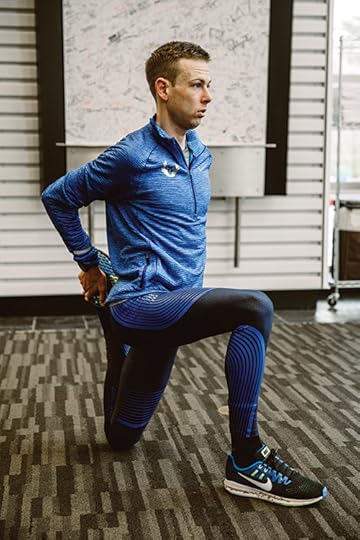
Another commonality between Salazar and Rupp is their complete dedication. No matter the training, Rupp is all in. Aside from his medals and the career he’s had to date, this is what truly makes Rupp stand out, according to Nike Oregon Project teammate and frequent training partner Jordan Hasay, who will make her marathon debut in Boston.
“I think what sets Galen apart is his commitment to the process,” she says. “He approaches everything that he does with commitment, and gives his absolute best every single day. I also think his attitude and life off the track help him to be such a great athlete. He cares the most about his faith and his family. This allows him to compete with a lot of purpose and strength.”
Putting in the work is one thing. But winning a marathon also requires the courage to mix it up with a lead pack of lithe and seemingly unbreakable east Africans. This is typically a big mental block for runners from the rest of the world. Rupp seems fearless about it, though—after all, he’s spent his track career among them.
“When I was really young it definitely seemed like more of an obstacle, because there weren’t a lot of Americans competing with those guys at all,” Rupp says. “The Africans definitely dominate. But my philosophy has always been to just keep chipping away. You can’t worry about these big jumps. It might seem crazy what some of those guys are doing as far as how fast they’re running. And over the years I kept getting closer and closer and closer, and then eventually in 2012 I beat all those guys [in the Olympic 10,000m final], except for one of them—Mo [Farah, a naturalized British runner of Somali descent], who’s my training partner!”
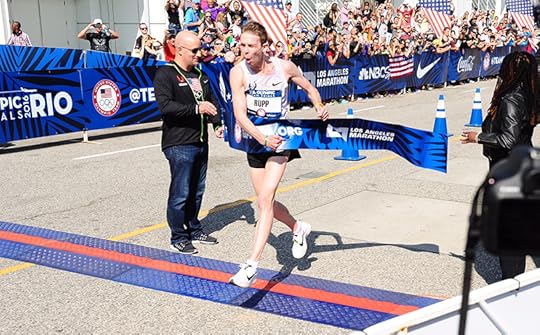 Rupp’s marathon debut win at the 2016 U.S. Olympic Trials Marathon. Photo: Ryan Bethke
Rupp’s marathon debut win at the 2016 U.S. Olympic Trials Marathon. Photo: Ryan Bethke
There’s no question that how Rupp fares in Boston will affect public perception of him. His very first marathon, the Olympic Trials in Los Angeles in February 2016, provided a visible turning point in the race where the baton seemed to be passed—or rather, snatched—from Keflezighi to Rupp. It was mile 23 on a dangerously hot day, and the two were all alone in front, Olympic qualification safely assured for each. Keflezighi was even a bit annoyed that Rupp, who has been conditioned to running in a tight pack around a track, was hanging so closely on Keflezighi’s shoulder despite having the whole road to run on. But in an instant, Rupp accelerated away, as if he downshifted and floored it, knocking out a 4:47 mile and going on to win by 68 seconds.
It also felt like a turning point in the running community’s perception of him. The editors of LetsRun, the sport’s foremost website for running chatter, breathlessly wrote following the race that “America’s next great marathoner has arrived” and that Rupp “utterly destroyed” the field. On the site’s popular message boards, ordinarily full of ridicule, contempt and slanderous descriptions of Rupp that are unprintable here, commenters largely wished him well in the Olympic marathon and vowed to root for him. It was a complete reversal in tone. Will a strong result in Boston make people similarly forget the latest media coverage, for better or for worse? The coach-protégé storylines would almost write themselves.
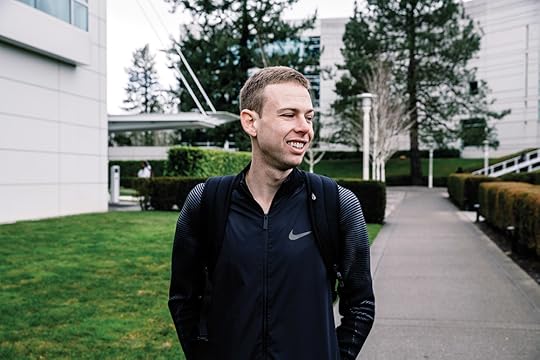
However it plays out, Rupp has his eyes focused on 2020. He and his coaches are doing everything it takes for success in that specific race three years out, and working backward from there. To them, everything else is just distraction.
“Right now I kind of have the blinders on and am training a bunch,” Rupp says. He was talking about how his current high-mileage training block lacks race specificity, which will come soon. But the metaphor is apt. He’s focused only on training, racing and winning in Tokyo in 2020. Everything else is for the rest of us to discuss.
The post Galen Rupp Makes His Boston Marathon Debut Amid A Storm appeared first on Competitor.com.
March 15, 2017
Experience the 2017 Los Angeles Marathon Course Via Snapchat
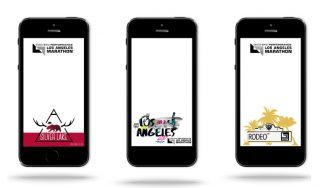
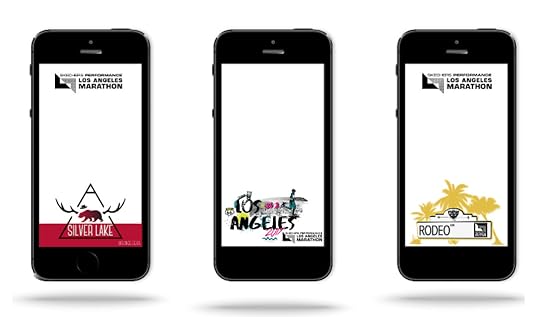
A glimpse of the 40 specially-designed Snapchat Geofilters for race day. Photo Courtesy of Skechers Performance
The 2017 edition of the Skechers Performance Los Angeles Marathon, which ranks as the fourth largest U.S. marathon and tenth in the world, has even bigger plans for race weekend.
Using more than 40 specially-designed Geofilters, the first-of-its-kind partnership between Snapchat and the Skechers Performance Los Angeles Marathon, will make social media history by allowing runners to “Run. Snap. Swipe. Celebrate!” their way over the 26.2-mile route.
The on-demand Snapchat Geofilters are woven throughout the race’s route, with tie-ins to Dodger Stadium, Rodeo Drive, Silver Lake, Santa Monica Pier, and many other location-based landmarks along the “Stadium to Sea” marathon course. In addition to featuring landmark-themed graphic overlays every mile, the social media app will also allow runners, spectators and volunteers to capture and share their marathon moments with marathon-inspired, unique images.
Snapchat is going for a record “longest on-demand Geofilter initiative” during the March 19th event and, given the 24,000 runners and more than 500,000 spectators expected to attend the marathon event, this is likely to be the largest Snapchat initiative ever conducted in conjunction with an endurance community.
However, Snapchat isn’t the only novel element to the race this year. Another is that Skechers Performance, a division of Skechers USA, Inc. and title sponsor of the marathon, has launched a “Road to Los Angeles” global marketing campaign. The program will bring more than 60 runners from 35 countries to the race, all receiving VIP experiences courtesy of Skechers.
Among the invited runners participating in the Road to Los Angeles program are Chan Kwok Keung, who helped popularize trail running in Hong Kong, teaching more than 3,000 students in the past couple decades free-of-charge. Another runner, Kavita Tungar, is India’s current 10K national record holder. Zarelda Goh is the editor of Shape magazine in Singapore, and Gerald Anderson is an actor, producer and triathlete from the Philippines. Skechers is capturing these marathon runners’ training and race experiences on SkechersGOrunLA.com and via social media channels, via #GORUNLA.
The idea of bringing so many runners from such a variety of backgrounds and nations is to help step up the success in international growth Skechers has seen since its recent sponsorship of the Los Angeles Marathon last year, when it shared the weekend with the U.S. Olympic Trials Marathon, where Meb Keflezighi, one of Skechers Performance’s sponsored runners, qualified for the Rio Olympics. The runners of the Road to Los Angeles program aim to enhance the race’s diverse make-up and amplify its international appeal.
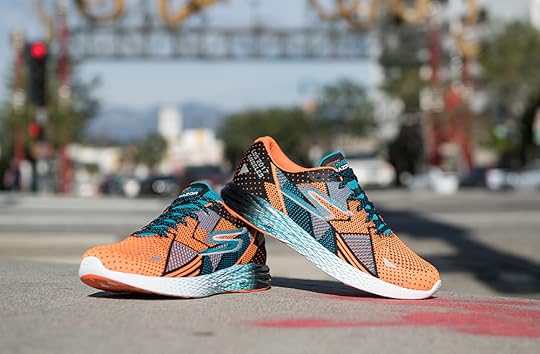 Skechers Performance’s Los Angeles Marathon special-edition shoes of the GOmeb Razor. Photo: Courtesy of Skechers Performance
Skechers Performance’s Los Angeles Marathon special-edition shoes of the GOmeb Razor. Photo: Courtesy of Skechers Performance
Skechers Performance has added another piece of flare to the marathon with the debut of three special-edition Los Angeles Marathon versions of the GOmeb Razor, GOrun Ride 6 and GOrun Forza 2 “Fo Sho” shoes available as official race merchandise as of March 1. A fourth shoe, the GOrun Forza 2 “OMG” model, will only be available at the Skechers Performance official race merchandise booth at the their Health & Fitness Expo on March 17 and 18 held at the L.A. Convention Center. The “OMG” model features a bold “Los Angeles” graphic across the shoe, from heel to toe.
Finally, the marathon will play host to a 13-person relay team fielded by the city’s newest NFL team, the LA Chargers. The LA Chargers linebacker Denzel Perryman, General Manager Tom Telesco, Chargers Cheerleaders and Super Fans will all be part of the team. In addition to the relay team the marathon will support 95 charity partners and is expected to raise $4 million for the charity partners’ causes.
RELATED: 10 Reasons the Los Angeles Marathon Should Be On Your ‘Must-Run’ List
The post Experience the 2017 Los Angeles Marathon Course Via Snapchat appeared first on Competitor.com.
Pittsburgh To Host USATF Half-Marathon Championships
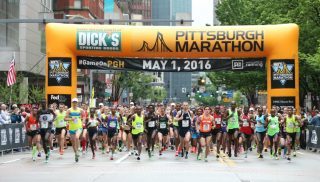
Photo: Courtesy of DICK's Sporting Goods Pittsburgh Marathon
(c) 2017 Race Results Weekly, all rights reserved.
The UPMC Health Plan Pittsburgh Half-Marathon, part of the DICK’S Sporting Goods Pittsburgh Marathon weekend of events organized by P3R, has been selected as the USA Half-Marathon Championships for men and women in 2018 and 2019 by USA Track & Field. The events, scheduled for the first weekend in May, will offer $85,000 prize money purses in both years.
“We are honored to host a USATF National Championship and invite America’s best runners to the ‘City of Champions,'” said P3R CEO Patrice Matamoros through a statement. “The presence of such talented runners will bring added excitement to the entire field of runners and will also increase the prestige and footprint of the Pittsburgh Marathon event for many years to come.”
The Championships will also be part of the USA Running Circuit, a distance running series featuring USATF Championships from one mile through the marathon. The series attracts some of the best American distance runners with more than $500,000 to be awarded annually in total prize money.
In 2018, P3R will also celebrate the 10-year anniversary of the return of the Pittsburgh Marathon after a 5-year hiatus from 2003 to 2008. The historic Pittsburgh event returned in 2009 and has inspired a running renaissance in the region. Pittsburgh was named one of the “Best Cities for an Active Lifestyle” by WalletHub in 2017. In addition, the Steel City has hosted six USA Marathon Championships including two U.S. Olympic Marathon Trials (women, 1988 and men, 2000).
The post Pittsburgh To Host USATF Half-Marathon Championships appeared first on Competitor.com.
March 14, 2017
Shoe of the Week: Altra King MT
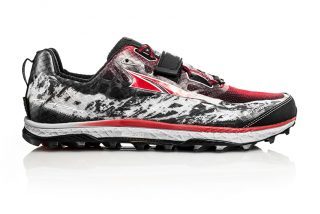
With traction that gives you the feeling of wearing full-length XC spikes and a shock-dampening yet energy-returning midsole, Altra’s new King MT brings something new, different and desirable to the trails. The King MT rides the emerging midsole wave of encapsulated foam compounds—read: boost-like—to give the King MT rebound and durability over many a hard trail miles. The 6.5mm-length Vibram outsole lugs are practically slip proof and, teamed with a full-length rock plate, they give you tremendous confidence that you can land almost any leap or bound. Altra bolsters that confidence with a Velcro strap across the mid-foot for quick lockdown on technical descents or gnarly scrambles. Testers found the sizing was accurate and they welcomed the zero drop and wide toe box that are signatures of the brand.
This is the shoe for you if … you’re looking for a low-profile trail shoe that still gives plenty of energy return and support in the midsole on super technical trails.
Price: $140
Weights: 9.5 oz.
Heel-toe offset: 0mm
Info: altrarunning.com
RELATED: Shoe of the Week—Under Armour Horizon KTV
The post Shoe of the Week: Altra King MT appeared first on Competitor.com.
How To Overcome 10 Common Complaints About Running

Photo: Shutterstock.com
For all of running’s feel-good and healthy benefits, it does have some downsides. And these blights can be real no matter how long, or not, you’ve been lacing up. Instead of seeing them as roadblocks, though, look at them as obstacles or a hurdle to get around or over. Because when it comes to what makes a run average, good or great, it’s often all about your attitude.
RELATED: How to Beat 6 Common Excuses for Not Running
It’s hard
If you’re just beginning a running or training program, you’re right, running can be hard, especially if you’re comparing it to lounging on the sofa. Think how much better that sofa will feel after a run. But seriously, it isn’t easy, which is why everyone doesn’t do it. The good news is that running gets progressively easier as your body becomes conditioned to the high impact and cardiovascular workout. And that takes time. Easing into a running program and consistency are two critical factors for helping your body adjust. Commit to running two to three days a week or every other day, adding days and miles as you adjust. Be sure to take walk breaks if needed, warm up with some dynamic stretching before each run, and run with a friend to hold you accountable.
The chafe is real
If you are lucky enough not to notice chafe during a run, there is nothing quite like the soul-searing feeling of a hot shower hitting raw skin. The key is to stop chafe before it begins. Look for seamless apparel or gear with flat and strategically placed seams. Lube early and often, in high-chafe areas at least. And ditch old gear when it begins to rub you the wrong way. Compression shorts, capris and tights are all helpful in minimizing the amount of fabric between your legs and reducing thigh chafe.
What’s up with my gut
Starting line port-o-johns are some of the nastiest you’ll experience. Chalk it up to early mornings and nervous excitement. But what about the insidious “runner’s trots” that happen even on normal days—they blow, quite literally. While every tummy is different, there are some things you can do to minimize the issue. Staying well hydrated, avoiding known belly irritants (like dairy, artificial sweeteners and excessive amounts of caffeine) and giving your body two to three hours to digest a pre-run meal may help to lessen problems. Otherwise, your best bet is to be prepared. Map out pit stops along your favorite running routes and, if you run with a pack, carry a few extra pieces of toilet paper, just in case.
RELATED: Why Do I Have To Poop When I Run?
Blisters
Much like chafe, blisters can happen to any runner at any time—new shoes, a new shoe and sock combo, toenails trimmed or filed a different way, jungle hot and wet race conditions—take your pick. Avoidance is key, but sometimes blisters still happen. Finding smooth fitting socks that work with your feet is essential. As is taking care of your feet. Keep them moisturized, check for blisters and hot spots, pre treat with lubricant, bandages or blister treatment patches and address any issues before they get worse. One sure thing about blisters is that you can feel them coming on, meaning you have the opportunity to stop them before they stop you.
Gnarly nails
Wearing flip-flops all the time may not be the best bet for your feet, but there’s no denying how good they feel after peeling off sweaty running socks! At least until you catch a glimpse of your gnarly runner toes—lost, black and misshapen nails are commonplace among runners. But it doesn’t have to be the case. Think of the injuries as your tootsie’s way of asking for some TLC. First things first, make sure your shoes are big enough! Toes need room to spread and stretch. In addition to having at least half a thumb’s width to full thumb’s width of space between the end of your longest toe and the toe of your shoe, consider shoes with a wider toe box, especially if you’re having nail issues. Also keep your nails filed squarely to prevent toe bang and ingrown toenails (not only does it hurt like the devil, it’s also a quick way to lose a nail and possibly injure your nail bed).
Exhaustion
As runs become longer and more frequent, it’s normal to feel more tired. Not just from the effort, but also because sleep is the best way for your body to recover from the increased stressors. It’s not to say you still can’t go out and dance the night away, but those nights are probably best saved for after a goal race instead of during a hard training phase. Also, remember to keep easy runs easy to enable your body to also recover on the go.
An insatiable appetite
Simple math says the more you run, the more calories you burn and the more calories your body will need. True, but you need to be smart about what you eat. Food is fuel for your body and your workouts. Nutritious choices can help you recover faster, give you the nutrients you need to nail a hard workout and make you feel better overall. Empty calories on the other hand (sugary sweets, a third slice of pizza or a double order of fries with cheese sauce) burn off quickly, leaving you hungrier than before and possibly bonking mid-run or race. Save the treats for after a big run when your body will actually appreciate the sugar and use it to top off glycogen stores.
RELATED: The New Rules of Marathon Nutrition
The cost
The cost of entry for anything new can seem prohibitive. But running really isn’t that bad. With plenty of good shoes hovering around the $100 mark and smart shopping for apparel, you can easily be out the door for less than $200. Not only is that cheaper than a gym membership (or a couple dinner dates), running is also something you can do anytime and anywhere. Add in the fresh air and sunshine and it’s downright priceless.
The time it takes
Really? Try again. Time spent running is an investment in your health, and good health is everything. Sure, making long training runs fit in a busy schedule may take some planning. But you’ll feel much better post-run than if you spent those 2 to 3 hours binge watching The Walking Dead. Plus, you can still do that after you run.
Loads of laundry
No doubt, running clothes do make for an extra outfit every day, which sounds like a lot. But, in reality, it maybe adds up to one additional load of laundry a week. Just like with training, if you stay on top of it, it’s no big deal. You can even make it a workout by doing calf raises and squats while folding clothes.
RELATED: 10 Amazing Benefits of Running You Might Not Have Known
The post How To Overcome 10 Common Complaints About Running appeared first on Competitor.com.
March 13, 2017
10 Running Races To Help You Celebrate St. Patrick’s Day
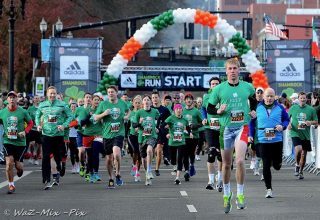
adidas Shamrock Run Portland; courtesy of Desiree Hamilton
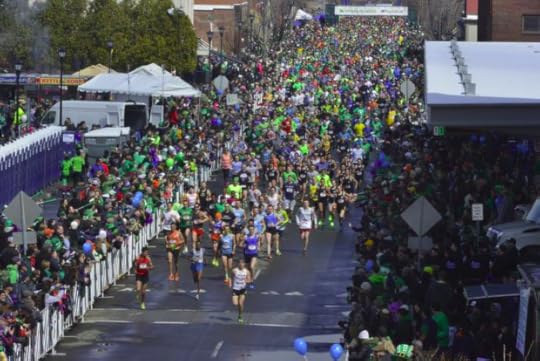
Holyoke St. Patrick’s Day Road Race; Photo: Brian Donoghue
St. Patrick’s Day is quickly approaching on March 17 and though many cities—including Chicago—have already observed the holiday, there are still plenty of opportunities to don some green apparel and get festive. We’ve rounded up some of the top St. Patrick’s Day races to get you in the spirit. May the luck of the Irish carry you to a PR!
RELATED: 4 New Races To Get On Your Radar This Year
Holyoke St. Patrick’s Day Road Race
March 18, Holyoke, Mass.
holyokestpatricksroadrace.org
Started in 1976, this annual 10K starts at 1 p.m., giving you plenty of time to celebrate before and after you run. If your friends aren’t runners (gasp!) there is a 2-mile walk option, as well, so everyone can get in on the festivities. The fun isn’t over after the race is done—the Holyoke St. Patrick’s Day Parade takes place on Sunday.
St. Patrick’s Day Fun Run Presented By Idaho Central Credit Union
March 18, Boise, Idaho
ymcatvidaho.org
A race for all ages—thanks to the 1-mile, 5K and 5-mile options—the festivities begin at 9:30 a.m. at Julia Davis Park. There are awards for the top five best dressed Leprechauns or Green Runners—so get into the holiday spirit—and stick around for healthy snacks after the race. All proceeds benefit the YMCA Team Idaho Track and Cross Country Club.

Six Tunnels To Hoover Dam St. Patrick’s Day Half Marathon; Photo: Craig Towler
Six Tunnels To Hoover Dam St. Patrick’s Day Half Marathon
March 18, Clark County, Nev.
bbscrun.com
This half marathon, 12K, 5K and 1-Mile race let’s runners spend their St. Patrick’s Day weekend on the Historic Railroad Trail. Hosted by BBSC Endurance Running, all race distances have stunning views with half-marathoners getting to see Lake Mead National Park as they pass through all of the six tunnels leading to Hoover Dam. Finishers receive a medal and post-race food to fuel after the race.
Mt. Bachelor Rotary Club St. Patrick’s Day Dash
March 18, Bend, Ore.
bendstpatsdash.com
This family-friendly 5K brings all of Bend to Deschutes Brewery & Public House, where you’ll find the start and finish line. The race benefits the central Oregon non-profit The Kids Center and if you can’t run, you can still donate to the charity and come out to support the runners by being a volunteer. Be sure to dress up and you might win the honor of Best St. Paddy’s Day Costume.
St. Paddy’s Day Mile
March 18; Sioux Falls, S.D.
stpattysdaymile.com
If you’re running the Mile, get ready for a point-to-point race that starts in front of the Federal Building. Runners who’d like a little more distance head to Fawick Park to run either a 5K or 5-Mile race. Run all of the races and you’ll be dubbed an Irishman. Be sure to stick around for the post-race party and sip on some Irishman Ale, a special brew created in honor of the race!
St. Patrick’s Day 4-Miler
March 18, Powell, Ohio
m3ssports.com
Head to the Kinsale Golf and Fitness Club for this unique race distance, complete with a post-race party and concert. The event, coined as a “running and walking event slightly veiled as a reason to party” is the perfect way to celebrate the holiday with family and friends. Stick around the club after for their family-friendly festivities and enjoy a complimentary beer to rehydrate.

adidas Shamrock Run Portland; Photo: Desiree Hamilton
adidas Shamrock Run Portland
March 19, Portland, Ore.
shamrockrunportland.com
This is how Portland kicks off their running season, making it a must-do event. Head to Waterfront Park and run either the half marathon, 15K, 8K or 5K to get in the St. Patrick’s Day spirit. At the finish line, all runners can celebrate at the Widmer Brothers Beergarden with a cold beer, listen to live music and chow down on hot Shamrock Irish potato soup.
Boys & Girls Club of Boston St. Patrick’s Day Road Race
March 19, Boston, Mass.
www.bgcb.org
This Boston tradition was started in 1940 and the 5K is still going strong today. The race starts and finishes in the southern part of town at the Edgerley Family South Boston Club. Don’t leave after the race or you’ll miss the Southie Parade at 1 p.m. This is a big race, so get there early!

St. Patrick’s Day 15K & 5K; Photo: Kristen Leitao
St. Patrick’s Day 15K and 5K
March 19, Temecula, Calif.
sandyfeetevents.com
This year marks the 6th annual running of the St. Patrick’s Day 15K and 5K located in Cougar Vineyard & Winery. Celebrate the holiday in wine country while running through vineyards and country roads. After making your way through the challenging hilly course, you’ll be greeted at the finish line with a glass of green bubbly.
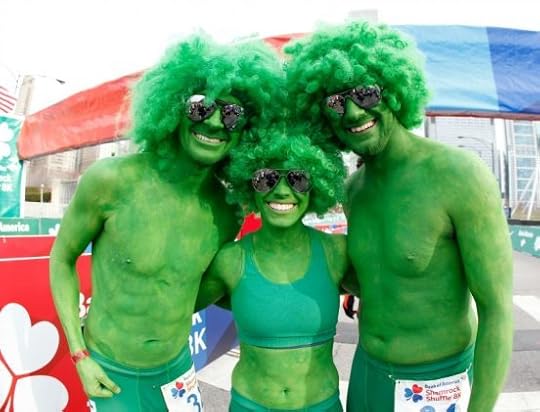
Bank of America Shamrock Shuffle 8K; Photo: Cindy Hamilton
Bank of America Shamrock Shuffle 8K
April 2, Chicago, Ill.
shamrockshuffle.com
Chicago is known for its St. Patrick’s Day celebrations and they keep the party going as long as they can. The Bank of America Shamrock Shuffle 8K may be in April, but everyone comes out with Irish spirit to kick off running season in the city. You’ll start and finish this iconic race in Grant Park and weave your way through downtown Chicago, along the way!
RELATED: 6 U.S. Mile Road Races to Test Your Speed and Go All Out
The post 10 Running Races To Help You Celebrate St. Patrick’s Day appeared first on Competitor.com.
March 9, 2017
Michael Wardian Comes Back to Run Rock ‘n’ Roll DC for Another Win
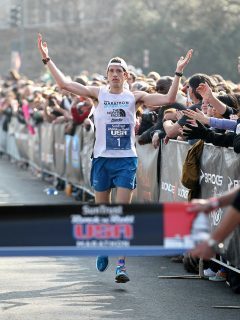
The last time Michael Wardian claimed a victory at the Rock 'n' Roll Washington D.C. Marathon in 2012. Photo: Photorun.net
When you are a husband, a father with two young sons, an international ship broker and a world-class marathoner/ultra-marathoner with some zany accomplishments, you multitask.
So, for an interview covering a range of subjects leading up to Saturday’s United Airlines Rock ‘n’ Roll Washington D.C. Marathon and Half Marathon, 42-year-old Michael Wardian stepped on the treadmill in his D.C. office/garage during lunch hour, set it on a 12-percent incline, and chatted away.
The Arlington, Va., resident, began the day with a 10K jog to the office. His commute would include a return run home. He’s a six-time winner of the Rock ‘n’ Roll D.C. Marathon and will lace up the kicks again on Saturday.
“What I like about running is I don’t care who you are, where you come from, what you’ve done in the past, it’s very finite,” Wardian said. “You do the work, you get the results. There’s no hiding. Running is really pure.”
The list of that-can’t-be-possible feats Wardian has pulled off stretch longer than any ultra course. The Cliffs Notes highlights: former world record for fastest marathon pushing a stroller; former world record for fastest marathon on a treadmill; former world record for fastest marathon on a 200-meter track; pending Guinness world record for fastest marathon wearing an Elvis costume; three-time U.S. Olympic Trials Marathon qualifier.
In January, Wardian achieved arguably his most impressive accomplishment. He won the World Marathon Challenge, completing seven marathons in seven days on seven continents. Running first in Antarctica, then Chile, Miami, Madrid, Morocco, Dubai and finally Sydney, Wardian averaged 2:45:56 per marathon, crushing the previous record of 3:32:25 per marathon.
Wardian attributes many factors for his ability to run-run-run without melting into the pavement. At 6 feet, 140 pounds, he’s fanatical about his diet. He’s a vegetarian, loading up on organic fruits and vegetables.
After suffering five stress fractures to his pelvis, plus five hernias in late 2012, he has adopted a less-is-more philosophy. He used to train more than 100 miles a week. Now, it’s sometimes “only” 80.
But he thinks his mental state plays as much a role as physical factors.
“I’m really committed and passionate about it,” he said. “I love it. I love all aspects of it. I love being interviewed about running. I love the training. I love waking up early. But I really think it helps having the right mindset. And I’m really careful.”
Knocking off the World Marathon Challenge required a couple years of planning and tremendous sponsorship for an undertaking that cost $45,000. Starting in Antarctica, Wardian was exposed to temperatures that dipped to negative 22 Fahrenheit accompanied by winds that whipped to 30 mph. He credits wearing proper clothing, plus the experience of winning the 2014 North Pole Marathon helped him deal with the frigid cold.
“I was prepared mentally, and I had a really good kit,” he said. “With the right kit, a lot of things are possible which you think are really challenging.”
Five days later in Dubai, Wardian was running in triple-digit temperatures. “That kind of change,” he said, “is a huge ask of anybody.”
Hardly one to be consumed by the clock, Wardian appreciated memorable moments along the seven-continent journey. There was the time in Antarctica when the sun dipped behind the mountains amidst massive gray clouds and sunbeams began shooting between through the clouds.
“No one was around me and I’m thinking, ‘Oh my gosh, who gets to do this?’” he said. “It’s one of those moments I’ll remember for the rest of my life.”
There was the moment on South Beach in Miami when he was dodging strollers and bikes and stopped for a selfie with a spectator, who happened to be the guy Wardian barely beat in a race years ago.
There was Dubai, “Running by people who had no idea a marathon was going on, but by the end, they were connecting and cheering for us.”
He’ll be running closer to home on Saturday, where he won the event’s marathon in 2006, 2007, 2008, 2010, 2011 and 2012, and ran last year’s race in a Spiderman costume.
About running on home soil, Wardian said, “It’s terrific, man. It’s one of my favorites. It’s a beautiful race, a great way to reconnect with the local culture, the running people in D.C., and a chance to see all the sites.”
With the Washington Metropolitan Area Transit Authority metro system undergoing accelerated maintenance, there are a few changes to this year’s races.
Previously, the marathon and half marathon both started together at 7:30 a.m. On Saturday, the marathon kicks off at 7 a.m. and the half marathon at 8:30. Several blocks on 14th Street between Madison and Jefferson have been set aside for shuttle service.
The half marathon and marathon courses feature a slight change from about 1.5 miles through Mile 4. That route used to be off Memorial Bridge. Now it’s on portions of Rock Creek Parkway and the Potomac River Freeway.
Course director Keith Dowling, a former 2:13 marathoner who was a top American-born finisher at the 2002 Boston Marathon, feels the United Airlines Rock ‘n’ Roll D.C. Half Marathon is an excellent prep race before the Boston Marathon. The D.C. course features some early hills, and like Boston, allows runners to make up for any lost time with late descents.
“The mantra for runners is they have to keep the word ‘steady’ in their head,” Dowling said. “Keep that mantra, ‘steady effort.’ At 7.5 miles, you’re at the top. By Mile 8, you get a release to the downhill portion. You’re going to get all that time back if you’re patient.”
Between the 5K, half marathon and marathon, nearly 25,000 runners, walkers and wheelchairs have entered Saturday’s races. The Family Stone will serve as the finish line headliner of the Toyota Rock ‘n’ Roll Concert Series.
As for Wardian, when asked if he feels blessed to do what he does, he didn’t miss a beat while walking up the 12-percent treadmill incline.
“Especially after getting hurt,” he said. “Every day is something I cherish, and I do not take any day for granted that I’m able to do these things.”
RELATED: Running Washington D.C. With Michael Wardian
The post Michael Wardian Comes Back to Run Rock ‘n’ Roll DC for Another Win appeared first on Competitor.com.
How To Be Bold And Realistic When Setting Goals

Photo: Shutterstock.com
Goal-setting can be a confusing process for many runners—and for good reason. How do you set a goal that excites you, pushes you to achieve big things and improve as a runner while also being realistic about your abilities? After all, you want to challenge yourself but not set yourself up for failure before you even begin.
Typically, runners choose one of two types of goals:
1. A goal that’s too easy or doesn’t require very much work. For example: After running a few 10K races, you hope to run your first half marathon in 6 to 12 months.
2. A goal that’s wildly unrealistic. For example: You just started running and want to qualify for the Boston Marathon in three months.
The runner who made goal #1 above could be ready to run a half marathon in far less time. This goal is far too easy! And the runner who made goal #2 needs to have more perspective about the challenges of racing a fast marathon. It takes time and patience to reach this kind of goal!
Instead of goals that don’t challenge you or are impossible, there are two better types of goals to focus on: “small wins” and “stretch goals.” Both of these approaches give runners the advantage of thinking small about their daily training and to dream big about their future aspirations.
RELATED: Is Your Mental Game Keeping You From A Time Goal?
The value of small wins
Small win goals are short-term, highly achievable goals that force you to focus on the process of training—the daily actions that help increase your fitness, prevent injury, and get faster.
Rather than performance-oriented goals (like a time goal or reaching a new distance), small wins are about the “boring” elements of training like:
Getting enough sleep
Warming up properly before every run
Completing every strength and core workout
Running at a truly easy pace for your recovery days
These process-oriented, small goals have several unique advantages.
First, they’re easy to accomplish. Any runner can focus on these goals with no disruption to their current training. They’re not intimidating and they’re universal despite your age, ability, or the type of race you’re preparing to run.
They also make you a better runner. By getting more sleep, you recover faster and adapt better to the stresses of training. Warming up properly and being consistent with strength routines help reduce your risk of injury. Running easy on recovery days further enhances the recovery process. And fueling properly helps you feel more energized and perform at a higher level.
Small wins, when compounded over time, add up to a significant training advantage. You’ll be stronger, more athletic, and better rested with less risk of injury. Plus, accomplishing even the smallest of goals is motivating. Runners can “snowball” the accomplishment of these goals, build momentum, and run more consistently.
Set stretch goals to stay motivated
While small wins help you improve day-by-day and week-by-week, stretch goals are long-term pursuits.
This is when you’re encouraged to set big, bold, aggressive (but still realistic) goals:
Qualify for the Boston Marathon in 12-18 months
Break 25 minutes in the 5K this fall
Run your first half marathon within 6 months
Finally crack the 2-hour mark in the half marathon
Stretch goals are exciting. They make you think far into the future and imagine your potential abilities as a stronger, faster runner.
In other words, they keep you motivated to train. Even when it’s cold or dark outside and your warm bed is far more inviting, the prospect of accomplishing a stretch goal gets you out the door for your workout. A stretch goal ultimately gives you something to work toward—if training were a road trip, it’s your destination.
But don’t fall into the trap of being too aggressive with your stretch goal. It still needs to be realistic based on your current fitness level, ability, and willingness to put in the work required to accomplish it.
For example, if you want to qualify for the Boston Marathon and need to run a 3:30 marathon, but your personal best is 4:15, then it’s more productive to focus on breaking 4 hours first. This is still a big improvement and one that every runner should be very proud of accomplishing.
Or if you’ve only ever raced a 5K, a stretch goal might be to finish a half marathon in 3 to 4 months. However, making a jump from the 5K to the marathon in just a few months risks injury, mental burn out, and falling far short of this goal, which will only lead to decreased motivation.
By striking a healthy balance between process-oriented small win goals and larger, more exciting stretch goals, runners better set themselves up to succeed in the short and long-term.
Runners who adopt this approach will perform the daily actions that contribute to better running performances, while at the same time maintaining an exciting future-oriented goal that boosts motivation.
Soon, with a skyrocketing fitness level, you’ll realize those stretch goals are within reach!
RELATED: 6 Tips For Setting Goals This Season
* * *
About the Author:
Jason Fitzgerald is the head coach at Strength Running, one of the web’s largest coaching sites for runners. He is a 2:39 marathoner, USATF-certified coach and his passion is helping runners set monster personal bests. Follow him on Twitter @JasonFitz1 and Facebook.
The post How To Be Bold And Realistic When Setting Goals appeared first on Competitor.com.
March 7, 2017
Meb’s Top Tips for Injury Prevention
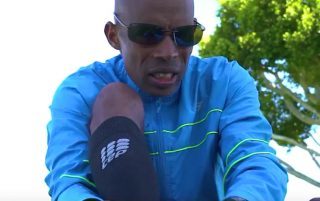
Meb shows us his top tips to prevent injuries:
Wear CEP compression socks
Cross-train with ElliptiGO
Stretch before and after running
The post Meb’s Top Tips for Injury Prevention appeared first on Competitor.com.
Nike Unveils Shoes Designed to Run a Sub-2-Hour Marathon
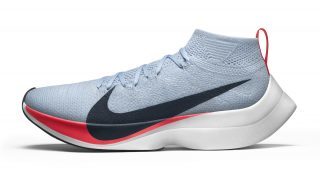
 Nike Zoom Vaporfly Elite, Photo: Courtesy of Nike
Nike Zoom Vaporfly Elite, Photo: Courtesy of Nike
You may have heard about Nike’s latest passion project recently—Breaking2, an all-out assault on the marathon world record using every means necessary to enable someone to run 26.2 miles in less than two hours: Sport science, nutrition, fine-tuned race tactics, and, of course, footwear.
While the Swoosh has walked its typical line of being both tight-lipped and very splashy about most aspects of the project, today it officially unveiled the shoe that its three runners—Eliud Kipchoge of Kenya, Lelisa Desisa of Ethiopia and Zersenay Tadese of Eritrea—will be wearing when Nike stages the grand attempt. (We can reveal, though, as of today, the location of the Breaking2 event: a 2.4K loop around portions of the Autodromo Nazionale track in Monza, Italy, home to Formula 1’s Italian Grand Prix.)
The shoe they’ll be running in is the Nike Zoom Vaporfly Elite. It looks crazy on the outside, and, according to the specs shared by Bret Schoolmeester, senior director of Global Running Footwear, it’s crazy on the inside as well.
 Nike Zoom Vaporfly Elite forefoot detailing, Photo: Courtesy of Nike
Nike Zoom Vaporfly Elite forefoot detailing, Photo: Courtesy of Nike
After starting at square one in designing the ideal footwear for a sub-2-hour marathon, the team initially conceived of a shoe that was little more than a track spike. It apparently didn’t get very far, because the runners balked at the lack of cushioning and protection for such an endeavor. So, in an effort to devise the ideal mix of weightlessness, energy return and aerodynamics, Nike came up with the Vaporfly Elite. It’s got a new midsole foam called ZoomX that Schoolmeester says is a third of the weight of standard EVA foam, and offers 13 percent better energy return.
Embedded within is a full-length carbon fiber plate to increase stiffness, reduce fatigue and minimize energy loss. Its curvature provides what Schoolmeester says is a downhill sensation when running in them. You can find carbon-fiber plates in track spikes, as well as everything from cycling to cross-country ski footwear, but they’re otherwise only found in a tiny handful of running shoes. The extremely upturned heel is said to “delay air separation and reduce drag,” according to Nike, as even in a marathon-distance effort, aerodynamics still play a large part when that effort is at sub-five-minute pace.
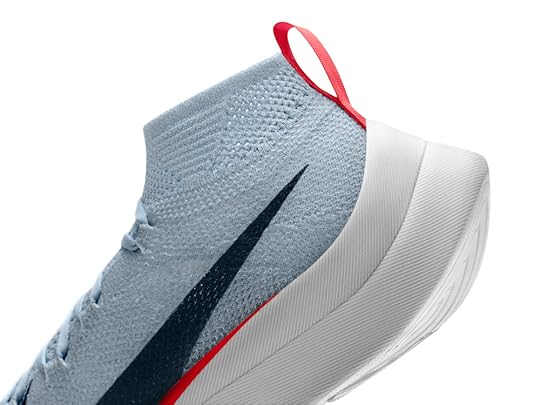 Nike Zoom Vaporfly Elite heel detailing, Photo: Courtesy of Nike
Nike Zoom Vaporfly Elite heel detailing, Photo: Courtesy of Nike
And while these shoes are built strictly for breakthrough performance—not looks—an audacious attempt like this demands audacious marketing: hence the oversize Swoosh spilling onto the midsole.
It’s got a 21mm stack height, with a 9mm heel-toe drop to go easy on the Achilles strain. Each pair will be tuned to the three runners mentioned above. By now you’re probably wondering about the cost: Unfortunately that’s irrelevant, because these shoes aren’t for sale.
Nike is, however, releasing two other shoes in this line: The Zoom Vaporfly 4% and Zoom Fly.
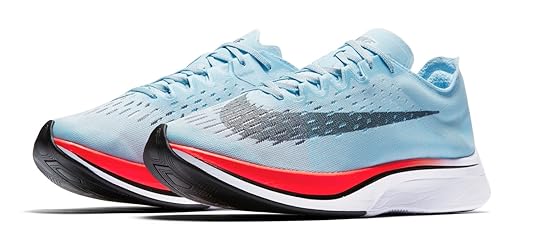 Nike Zoom Vaporfly 4%, Photo: Courtesy of Nike
Nike Zoom Vaporfly 4%, Photo: Courtesy of Nike
The Zoom Vaporfly 4% uses the same ZoomX midsole and carbon fiber insert, and a light Flymesh upper. It’s got a 10mm offset (31mm heel/21mm forefoot) and a men’s size 10 weighs just 6.5 ounces. You may have heard of a few runners who’ve already worn them: Galen Rupp won the Olympic Trials Marathon and a bronze medal in Rio in these; Amy Hastings and Shalane Flanagan each wore them at the Olympic Trials and in Rio as well; Eliud Kipchoge won the London Marathon and Rio Olympic gold in them. Oh, and the silver medal in the Rio Olympic Marathon was won in these shoes too, by Feyisa Lelisa. It drops on June 8, for $250.
 Nike Zoom Fly, Photo: Courtesy of Nike
Nike Zoom Fly, Photo: Courtesy of Nike
The Zoom Fly features the same upper as the Zoom Vaporfly 4% and a carbon fiber plate, but the midsole is made of Nike’s tried and true Lunarlon foam. It’s got heel-toe drop of 10mm (33mm heel/23mm forefoot). A men’s size 10 weighs 8.5 ounces. These also drop on June 8, for a (relatively) more economical $150.
Will the carbon fiber plate prove to move the needle in shoe design? It’s hard to say, but Schoolmeester notes that all kinds of testers—from heel strikers to forefoot strikers—said they like the feel. In addition to the downhill running sensation, Schoolmeester claims it lets people run with a taller posture.
Since there are only a tiny handful of runners who could even attempt to break two hours over 26.2 miles, anything this lightweight that actually reduces fatigue, helps improve posture and feels like running downhill sounds pretty amazing to the rest of us.
RELATED: Study Finds Sub-2-Hour Marathon Is Completely Possible
The post Nike Unveils Shoes Designed to Run a Sub-2-Hour Marathon appeared first on Competitor.com.
Ryan Hall's Blog
- Ryan Hall's profile
- 21 followers



